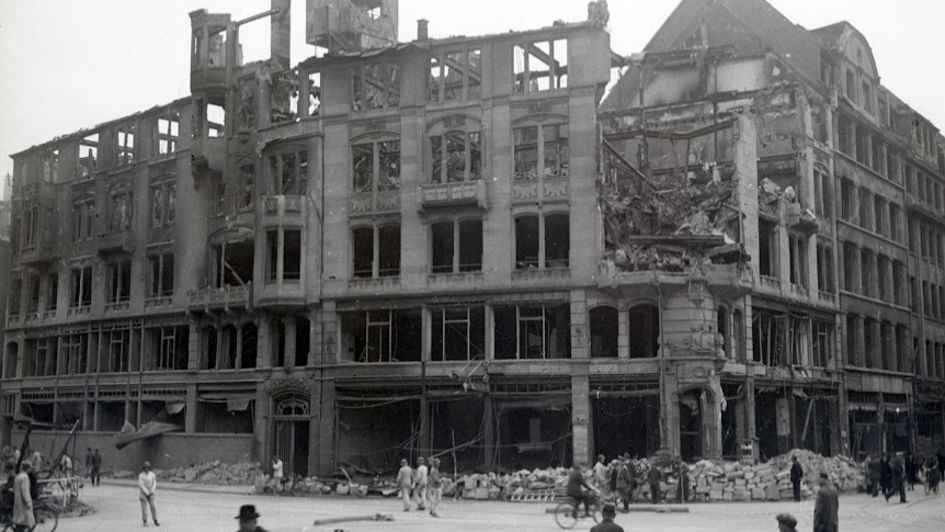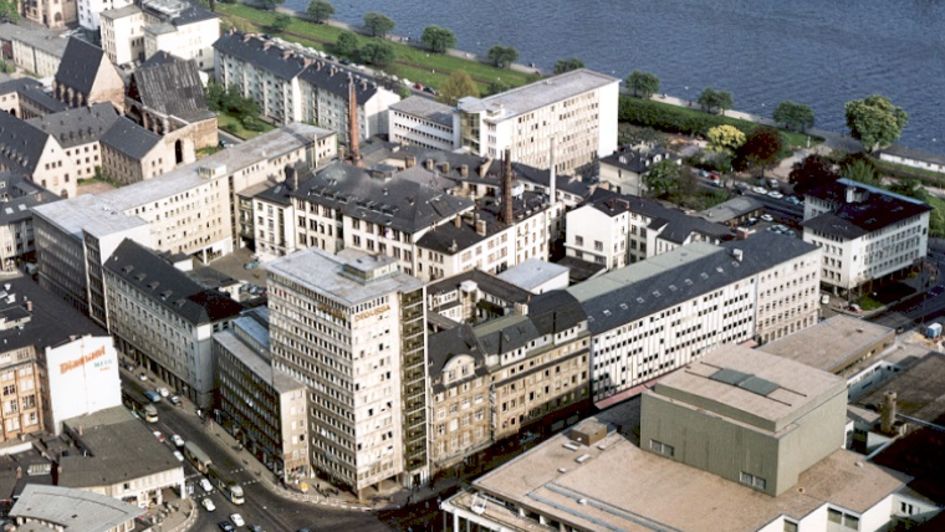Frankfurt am Main

Birthplace and Home of Degussa until 2001
Pioneering chapters in the history of Degussa have been written in Frankfurt, the economic and financial metropolis on the River Main. For 128 years until the merger of Degussa-Hüls AG with SKW Trostberg AG to form the new Degussa AG in February 2001, the fortunes of the company have been guided from Frankfurt. Frankfurt is the birthplace and home of the former Degussa AG.
Gold and Silver
The emergence of the Deutsche Gold und Silber-Scheideanstalt (German Gold and Silver Refinery, which became Degussa AG in 1980) in Frankfurt is closely associated with the history of the city in the first half of the 19th century. On March 23, 1841 the Council of the Free City of Frankfurt decided to appoint Friedrich Ernst Roessler to the position of Master of the Mint in Frankfurt. As the municipal officer in charge of coinage, he was assigned the responsibility by the Council to test the quality and weight of the coins minted in Frankfurt. He was also asked to set up an operation in the municipal mint building where precious metals could be separated. This plant was the origin of Degussa in Frankfurt.
On January 2, 1843, Friedrich Ernst Roessler took on the refinery plant independently. This operation in the municipal mint, for which he had to pay the lease and surety, was situated in the heart of Frankfurt on a piece of land that became known as 20, Münzgasse from 1848. The plant used the sulfur separation process, which is based on the principle that silver dissolves in concentrated sulfuric acid, but gold and platinum do not. The process created various chemical by-products, which Roessler processed in his separation plant. As space at the mint soon became insufficient for separation and for processing, Roessler looked around in Frankfurt for a new production location.
After a few short-term temporary solutions he finally found a suitable property in a street called Schneidwallgasse, very close to the municipal mint where, in 1860, he erected a three-story building in which he set up a chemical laboratory. This property, which in those days had the addresses 6 Schneidwallgasse and 5-7, Papageigasse, still forms the core of the Evonik site in Frankfurt today. In 1863 this business passed to his eldest son, Hector Roessler, who in the same year started producing silver nitrate and then potassium cyanide and other substances, thus founding a flourishing chemicals business.
In 1866, the Prussians marched into Frankfurt and the city lost its political sovereignty, which had an immediate impact on the Roessler business. The mint in the Münzgasse which had previously been run as a private business now became an official Royal-Prussian institution. The Frankfurt entrepreneur Friedrich Ernst Roessler turned into a Prussian civil servant. When the government gave notice on the rooms leased in the mint building, Heinrich Roessler, the second eldest son, moved the separation plant for precious metals out into his brother Hector’s chemical laboratory on Schneidwallgasse. A new factory for this laboratory was built on Gutleutstrasse near Frankfurt station. The land on which the factory was situated remained the property of Degussa until it was sold in 2001.
After 1868, the brothers Hector and Heinrich Roessler ran the separation plant for precious metals on Schneidwallgasse under the name “Friedrich Roessler Söhne” (“Friedrich Roessler’s Sons”) making it one of the oldest industrial businesses in Frankfurt. It remained in the city center for more than 100 years, until it was moved to Hanau-Wolfgang in 1972.
1871 saw the introduction of a common currency for the Reich. This threatened to fill the capacity of the separation plant to its limits as there were large quantities of old coins to separate and the Roesslers had their eye on the contract. However, realizing that they did not have sufficient capital, partly due to the fact that the authorities were asking for a great deal of surety, on January 28, 1873, the brothers founded a stock corporation and called it the Deutsche Gold- und Silber-Scheideanstalt vormals Roessler.
The injection of capital was urgently needed. After the contract was awarded, the quantity of coins to be separated grew in leaps and bounds. In 1874 the number of coins processed on Schneidwallgasse was ten times as much as in the previous years - in 1878 it amounted to 800 tons. Although some night shifts were introduced, it became impossible to deal with the vast quantities and eventually, bit by bit, the land around the separation plant was bought up and new premises built. As early as 1875, new buildings north and south of the original factory had been added and a new building for workshops, washrooms and changing rooms and a canteen was erected opposite the old institute.
Expansion of the trading arm in the 1880s forced increases in the number of sales and administration personnel. For this reason, the management decided to build the first Degussa building to be devoted entirely to administration. The employees moved into the new building on Schneidwallgasse in 1888. It was laid out on two floors with an open plan office, an auditorium and a gallery. Seventeen years later, in 1905, the company commissioned another large administration building in neo-Baroque style on Weißfrauenstrasse, which was completed in 1906. Neither building survived the air raids on March 22, 1944.

In 1911/12 the company installed a new production plant to extract and process precious metals, generating the construction of a whole series of additional buildings on the Degussa estate in Frankfurt’s city center in the 1920s and 1930s. In 1921 for example, a new laboratory was built on Weißfrauenstrasse followed by another quite close to it in 1925. In 1935 a building was erected to bridge Schneidwallgasse; in the same year, the front and rear annexes on Alte Mainzer Gasse were pulled down. A new laboratory was situated here by 1937 and the arch of its gateway still stands in the Westhof in the Frankfurt administration center to remind us of Degussa’s origins.
Under the swastika
Endeavoring to enlarge the estate in the city center in Frankfurt, which had yet again become too small, Degussa bought two properties in 1934 and 1935 that had previously belonged to Jewish companies, a contribution to the process called “aryanization.” The so-called Neptune House stood on the corner of Weißfrauenstrasse and Neue Mainzer Landstrasse where today the Degussa Tower stands and the second property was on Neue Mainzer Strasse.
As part of his research into the history of Degussa from 1933-45, the renowned US historian Peter Hayes (Theodore Zev Weiss Holocaust Educational Foundation Professor of Holocaust Studies at Northwestern University Evanston/Illinois, USA) published an essay on this subject in the Fritz Bauer Institute Yearbook for 2000: “The contribution of Degussa AG to aryanization – a history and evaluation”.
During World War II, research and manufacturing initially continued in Frankfurt. The devastating air raid on the city on the evening of March 22, 1944 brought production to an abrupt halt. Degussa’s main administrative building was seriously damaged.
The departments that had been rendered “homeless” overnight were accommodated in Wächtersbach and elsewhere in Frankfurt and in other sites that had been less badly affected. The entire research department moved to Konstanz and did not return until 1949.

The bookkeeping department and all its documentation had already been moved to Idstein, between Frankfurt and Limburg for safekeeping in 1943. The years leading up to the currency reform in 1948 were characterized more by a struggle to survive than by planned growth and economic management, which was the case for many other industrial sites in Germany. In a business report from that time it says: “We could not do much more than remove the rubble.”
A new start on the bomb site
In 1949 the employees were still in temporary accommodations on Neue Mainzer Strasse, where the Westbau, the West Building, was built in 1962. They were able to move into some parts of the newly built administration building in 1950. In the following years, rebuilding on Weißfrauenstrasse progressed faster. The Handelshof administration building was constructed on the corner of Untermainkai and Neue Mainzer Strasse and just a year later in 1953, the Degussa Tower on the corner of Weißfrauenstrasse and Neue Mainzer Strasse was ready for occupancy. After the Telecom Building and the Federal Railway Headquarters, it was the third highest secular building in Frankfurt at that time.
1956 saw the completion of the so-called Mainbau, which separates the Degussa estate from the banks of the River Main. Finally, the large administration building on the corner of Weißfrauenstrasse and Seckbächer Gasse was built in three phases between 1955 and 1959.
Tradition and change
In the 1960s, the technical Metal division expanded so much that production in the Frankfurt city center reached full capacity.

In 1967, the Board came to the obvious conclusion and bought some new land in Wolfgang, a district of Hanau. This step was also motivated by environmental protection regulations which had become more stringent, making it difficult to continue production in the center of Frankfurt.
At the beginning of the 1970s, the metal operation and metal separation started to move to Hanau-Wolfgang. The last section to move to Wolfgang was the gold foil manufacture, bringing a chapter in Frankfurt’s industrial history to an end. In 1979, the separation institute building, still known locally as “The Mint” was torn down, in order to make more space for a new administration building.
The new administration building had become urgently necessary. For some time now, the post-war buildings had not provided enough space for the total of around 1,850 employees. The construction of the new building began in October 1981 with excavation work for a three-storey underground car park. After completion of several construction phases, the employees moved into the new headquarters in October 1984. This cross building was located in the center of the Frankfurt site, exactly at the place where the company had laid its foundation stone with the former refinery.
After 142 years, the Frankfurt site, the former headquarters of Degussa AG on Weißfrauenstraße, was closed. The site is being further developed by Deutsche Immobilien Chance AG (DIC), which bought the site in 2005.
In the summer of 2010, the last employees moved into a new building built especially for this purpose in the Wolfgang Industrial Park in Hanau.
